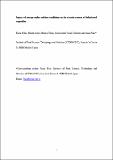Por favor, use este identificador para citar o enlazar a este item:
http://hdl.handle.net/10261/88205COMPARTIR / EXPORTAR:
 SHARE SHARE
 CORE
BASE CORE
BASE
|
|
| Visualizar otros formatos: MARC | Dublin Core | RDF | ORE | MODS | METS | DIDL | DATACITE | |

| Título: | Impact of storage under ambient conditions on the vitamin content of dehydrated vegetables |
Autor: | Peñas, Elena CSIC ORCID ; Sidro, Beatriz CSIC; Ullate, Mónica CSIC; Vidal-Valverde, Concepción CSIC ; Frías, Juana CSIC ORCID | Palabras clave: | Storage B-carotene Vitamin C Dried vegetables Thiamin |
Fecha de publicación: | abr-2013 | Editor: | Sage Publications | Citación: | Food Science and Technology International 19(2): 134-141 (2013) | Resumen: | The consumption of dehydrated vegetables, which provides an important source of vitamins, is increasing worldwide. Dehydrated vegetables are located on non-refrigerated shelves in food shops and, therefore, it is of utmost importance to understand the modifications that take place in the content of these labile micronutrients at the ambient conditions currently found in food shops. The present study discusses the effect of storage for 3, 6, 9 and 12 months on the content of thiamin and vitamin C in different commercial and pilot plant dehydrated garlic, onions, potatoes and carrots in darkness at room temperature under vacuum conditions. The content of b-carotene under these conditions was also studied in dehydrated carrots. Thiamin remained stable over the first 3 months of storage (#2;90% retention), while long-term storage led to larger losses (retention of 85% in garlic and 45% in commercial carrots after 12 months of storage). The content of vitamin C drastically decreased during the storage period and even disappeared in some dried onions and carrots following 12 months of storage. Storage for 6 months at ambient conditions preserved 80¿90% of the b-carotene content in dehydrated vegetables, while long-term storage led to significant b-carotene degradation (retentions between 43 and 81%). These results suggest that vitamins are gradually lost during storage at the practical conditions in food shops and will thus provide relevant information concerning dried vegetables, so manufacturers may calculate shelf life under established storage conditions. | Versión del editor: | http://dx.doi.org/10.1177/1082013212442188 | URI: | http://hdl.handle.net/10261/88205 | DOI: | 10.1177/1082013212442188 | Identificadores: | issn: 1082-0132 |
| Aparece en las colecciones: | (ICTAN) Artículos |
Ficheros en este ítem:
| Fichero | Descripción | Tamaño | Formato | |
|---|---|---|---|---|
| impact_storage_Penas.pdf | 395,39 kB | Adobe PDF |  Visualizar/Abrir |
CORE Recommender
SCOPUSTM
Citations
3
checked on 13-abr-2024
WEB OF SCIENCETM
Citations
2
checked on 15-feb-2024
Page view(s)
305
checked on 15-abr-2024
Download(s)
366
checked on 15-abr-2024
Google ScholarTM
Check
Altmetric
Altmetric
NOTA: Los ítems de Digital.CSIC están protegidos por copyright, con todos los derechos reservados, a menos que se indique lo contrario.
